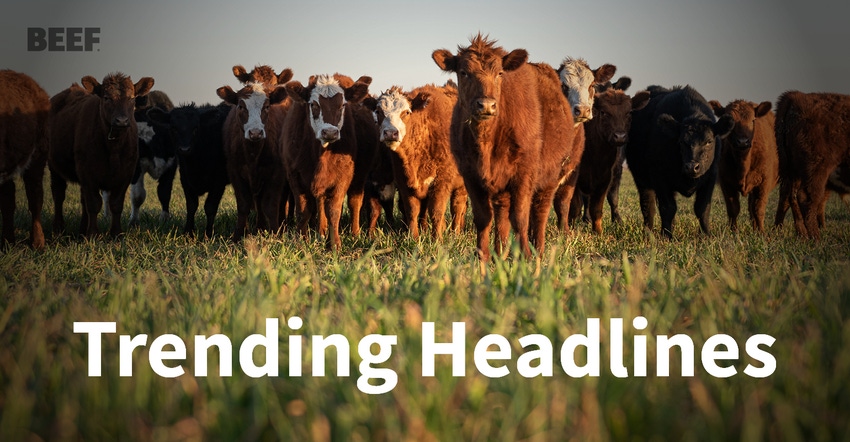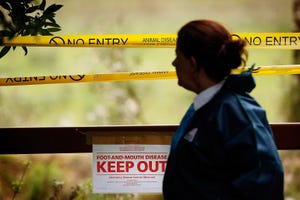5 Trending headlines in the world - Mar 22, 2022
Check out these stories to find out what is happening in the BEEF world.

It’s the end of March and it feels like it’s been a long month. Let’s face it, there has been a lot of negative things happening in the world and they are all impacting the beef industry.
1. Texas has been on almost everyone’s minds. Last week, wildfires broke out in the state. Dry and windy conditions fueled wildfires in different areas of the state. The Eastland Complex Fire burned more than 54,000 acres as crews continued to battle it.
By Monday night, the fire was only 60 percent contained, according to Texas A&M Forest Service, which does not project the fire to be wholly contained until at least Friday.
Towns have been evacuated over the past few days and many residents have returned to find homes charred and livestock killed including hundreds of cattle.
There is at least one wildfire still burning. However, now residents are dealing with the impacts of severe thunderstorms and tornadoes that tore through the state Monday night. There was hope that the rain would help the wildfire situation but it didn’t extinguish the fire in North Texas as many helped.
2. Also, not far from many minds is the Ukraine-Russia impact on beef markets. Many eyes are on the markets, not just the commodity prices or beef prices but the diesel prices as well. At $5 a gallon in many rural areas, beef producers are keeping their eyes on the pumps. Prices dipped a few pennies but not enough to stop the hurt for ranchers or farmers.
3. Wolves are becoming front page news again. A series of wolf killings on ranches in Jackson County, Colorado, have resulted in several cattle deaths and even six elk. Now, wildlife officers are delivering wild burros to a rancher in an attempt to decrease wolf depredations. The idea is to make the burros become a part of the cattle herd to where they will start to protect or consider the cattle as a member of the family.
4. Researchers at the University of Calgary are using Alberta beef and dairy cattle to conduct studies on antimicrobial use and resistance.
Herman Barkema is the scientific director of the Antimicrobial Resistance (AMR) One Health Consortium.
For years now, experts have warned that the overuse of antibiotics (one type of antimicrobial medicine) in both humans and farm animals is linked to a growing number of bacteria becoming resistant to medication.
According to Barkema, the main way antibiotic resistant bacteria could spread from farm animals to humans is through runoff water from fa rms, which can enter into drinking water supply or bodies of water where people swim.
“We really need to stop the increase of antimicrobial resistance, and the best wayt o stop it is to use less antibiotics,” says Herman Barkema.
One way, they are trying to do this is to precondition cattle so they can handle the stress they may encounter when entering a new phase such as to a feedlot so that antibiotics are not necessary.
5. In Brazil, cattle ranches are learning how to reduce carbon emissions from their ranch. The training is a new research project from the University of Colorado Boulder and the Climate Policy Initiative.
The study, in the Proceedings of the National Academy of Sciences, analyzes the results of a randomized control trial that examined whether agricultural extension services can help to restore cattle pastures in Brazil.
In addition, the net impact of the program on greenhouse gas emissions was equivalent to reducing carbon dioxide emitted into the atmosphere by 1.19 million tons—the same amount as the neighboring country of Paraguay emits in a given year.
The study is trying to fix the climate problem, Brazilian ranches has and that is that supply chains are responsible for 14.5% of global greenhouse gas emissions and account for as much as one third of total emissions in Latin America, totaling hundreds of millions of tons of carbon dioxide each year.
Mid-sized ranches, like the ones analyzed in this research, are responsible for one third of Brazil's cattle production. But unlike the cattle industry in the United States, which is dominated by feedlots, almost 90% of Brazilian beef is pasture- or grass-raised. What it means is a huge demand for pastureland.
And an extra for this week. While, there are many things to ponder this week, one thing is clear is that there are people ready to help those in need in Texas.
Ranchers in Carbon, Texas are gathering supplies for those impacted by the wildfires, hoping to gather hay and supplies for livestock. Also, the Texas A&M AgriLife Extension Service has also put a call out for help. A hotline has been set up at (979) 314-8200 for more information or check out the story on Beefmagazine.com.
About the Author(s)
You May Also Like


.png?width=300&auto=webp&quality=80&disable=upscale)
